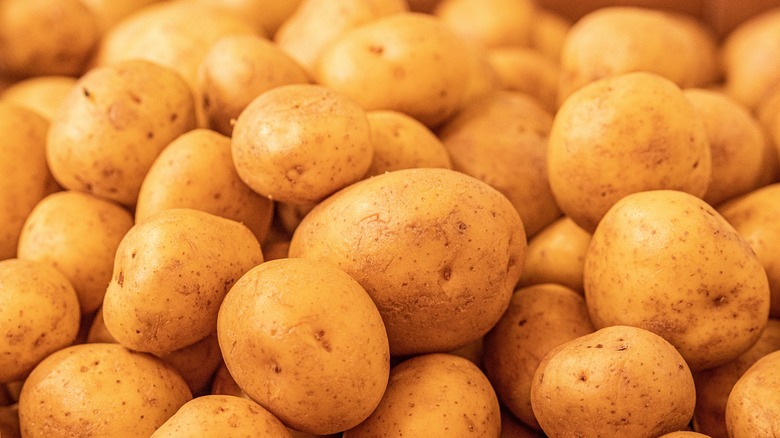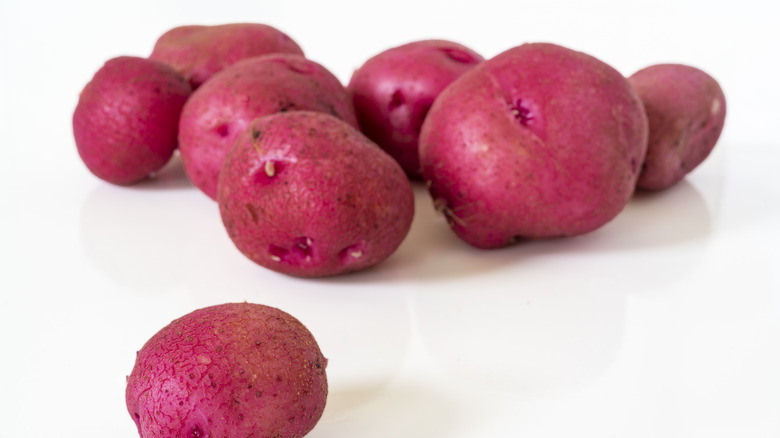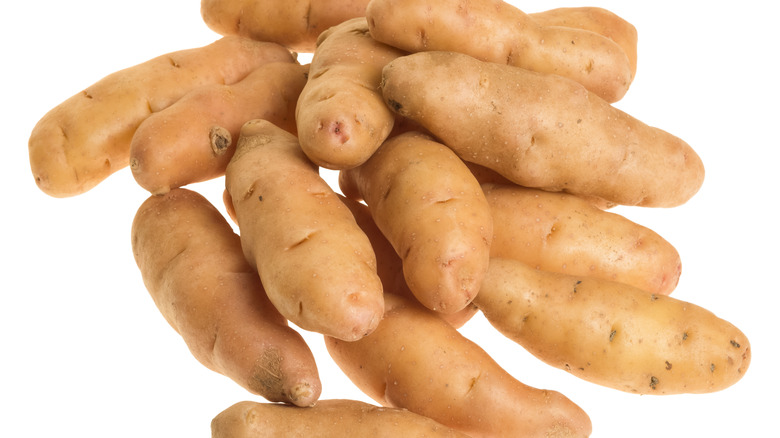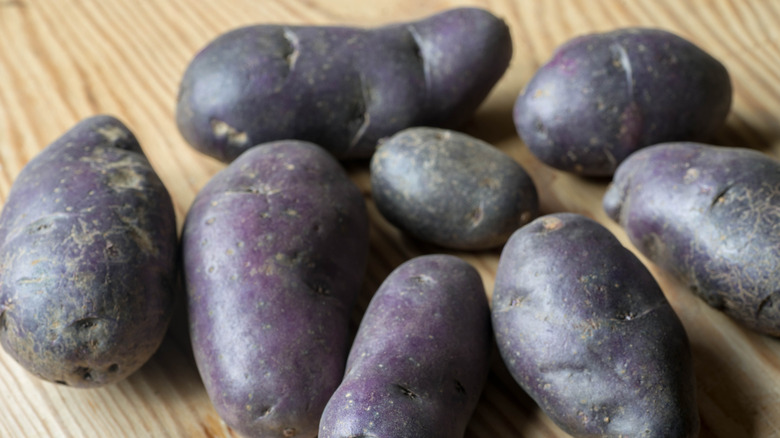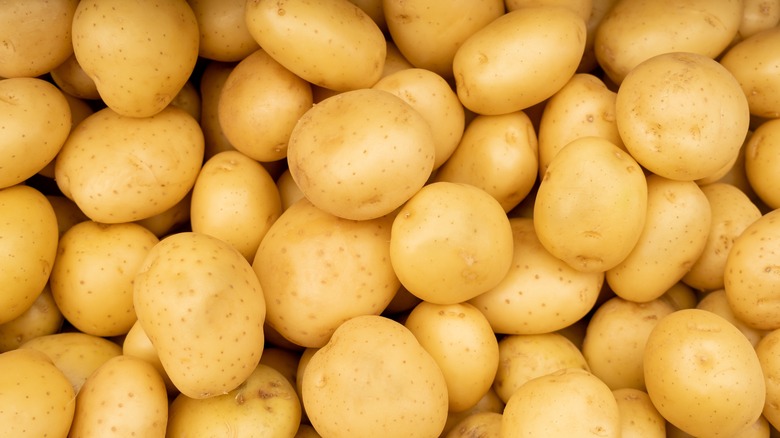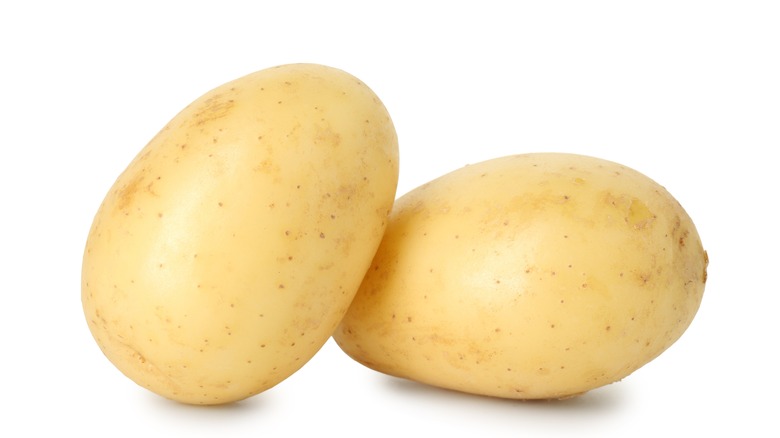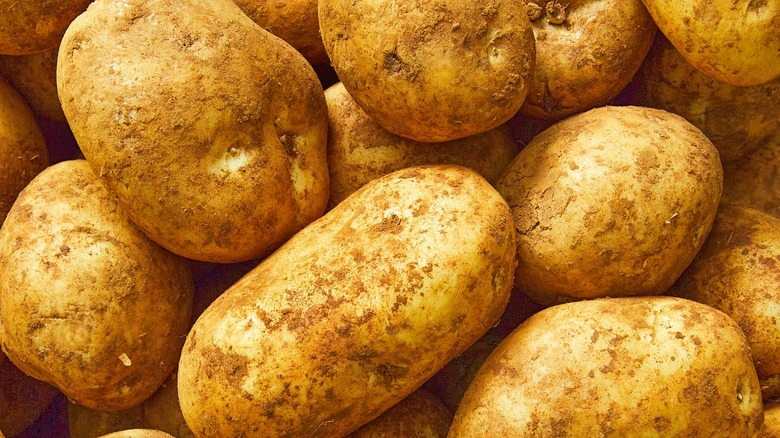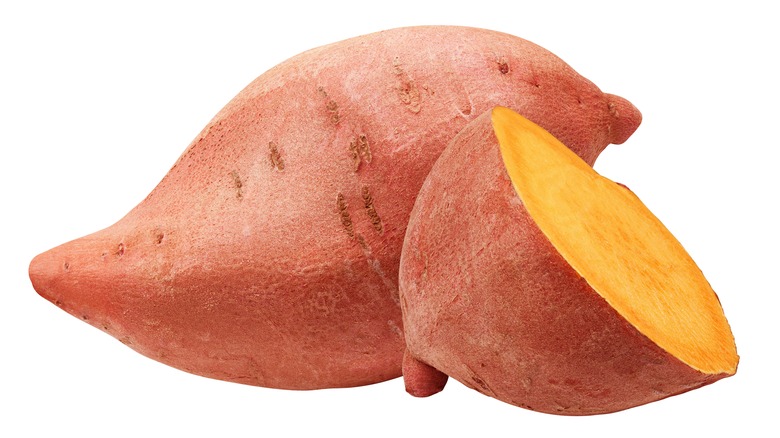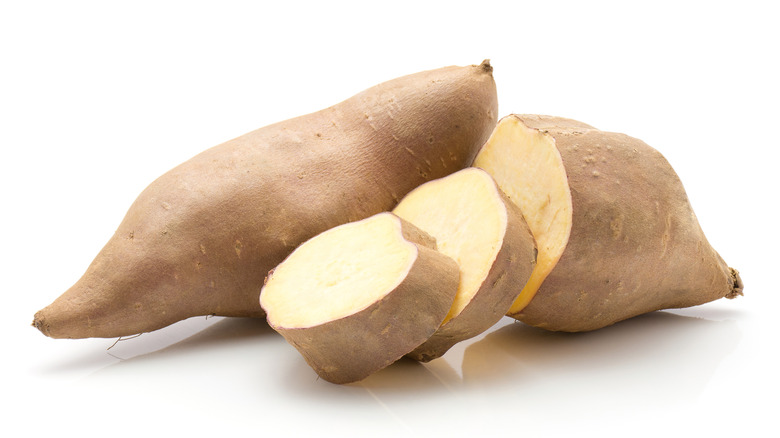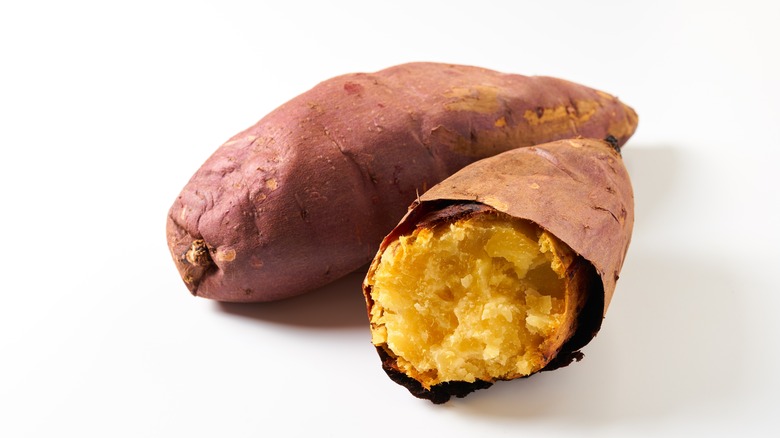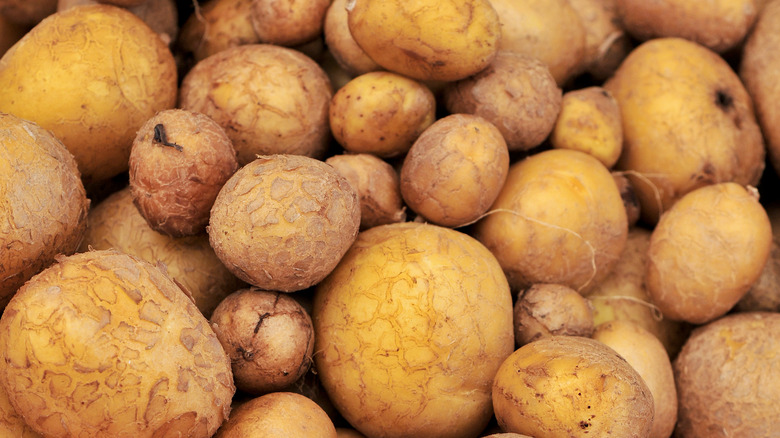12 Different Types Of Potatoes, Explained
There's no wrong way to eat a potato, but there is a better one, depending on the dish. Some potatoes break down into fluffy clouds that are great for mashing. Others stay firm and structured, built for salads, flaky skillet sides, or a nice tray of garlicky roasted wedges. And then there are those that surprise you with a deep buttery flavor, cool jewel tones, or the kind of golden crust you thought only restaurants could pull off.
In this guide, we're breaking down 12 of the most useful and flavorful potatoes you'll find at the store, from russets and Yukon Golds to white and orange sweet potatoes. Each has its own strengths; you'll find that some are great when crisped in oil, while others melt into soups or hold steady in galettes. Whether you're a fan of the classics or want to try something a little different (hello, Kennebec and Murasaki), knowing your spud's personality can seriously upgrade a meal. Because once you learn which potato belongs where, you'll stop guessing and start cooking with more confidence. Let's dig in.
1. Russet potatoes
Russet potatoes are your go-to classic, from potato skins and tater tots to gratin — they're perhaps the most used thanks to their mildly earthy, sweet taste and pillowy, dry texture. This is the type of potato you think about when someone says "baked potato." You know the one, with its rugged brown skin, oblong shape, and highly starchy interior. They cook up fast and turn out floury, which makes them great for light mashed potatoes, upgraded baked spuds loaded with all the fixings, or toasted halves with a good dose of melted butter in the middle.
They're also low in moisture, which helps make them crispy on the outside while staying tender inside. This is why russets are probably the best potatoes for beautifully cooked french fries and hash browns. But don't stop there, go ahead and slice them into wedges and roast them until golden, or cube and pan-fry them for a diner-style breakfast side. If you're after that crunchy crust and pillowy center combo, this is the one for you.
That said, russets aren't built for everything. Their starchiness means they'll fall apart in soups and salads, so skip them when you need potatoes that hold their shape. Save the russet for when softness matters most. Whether you're cooking for a crowd or making comfort food for one, russets are as reliable as they come, and when treated right, they deliver every single time.
2. Yukon Gold potatoes
Yukon Golds are the heavy-lifters on this list — they're neither highly starchy or waxy, but something in between. They're pretty flexible, so you can get away with using them for a lot of different dishes without having to adjust your recipe drastically. Their yellow flesh turns rich and flavorful with minimal seasoning, and the thin, smooth skin means you can often skip peeling — unless you're after extra-fluffy mashed potatoes, in which case a good (and cheap) peeler gets the job done fast. Get creative and roast Yukons with extra virgin olive oil and your favorite herbs, and let them cook a little longer than usual. They will be crispy on the outside and velvety on the inside. On the other hand, if you mash them they will be soft and golden with enough body to hold their own under heavy toppings like thick gravy.
While russets break down when boiled, Yukon Golds keep whatever shape you give them, which means they're good for potato salads, soups, fried cubes, and other dishes where firmness is crucial. Yukon Golds are particularly useful when you want a rich baked potato; skip the extra butter because they will get you there naturally. If you only have space for a few potatoes in your pantry or fridge, then keep this all-purpose friend in stock.
3. Red potatoes
Red potatoes are the ones you reach for when you want something easy, reliable, and colorful on the plate. You don't have to worry about peeling them (their soft skin cooks up beautifully), especially if you want that hint of red to stay visible. They're really handy when you're trying to achieve something that looks put-together with almost no effort.
They also have a naturally dense texture that holds up well in heat, so they won't go mushy on you. That makes them an exciting choice for all the rough-and-tumble cooking moves: think rolling boil, high-heat roast, hot skillet sear. You'll have no crumbling or soggy bites, just sturdy, slightly sweet potatoes that stay intact and soak up flavor without getting lost in the other ingredients.
One of the best things about red potatoes? They fit into your cooking like a missing puzzle piece. Cook them in a pan with a good drizzle of olive oil, roast them with an aromatic herb like rosemary, or smash and sear until the edges crisp well. No overthinking required.
4. Fingerling potatoes
If you're in the mood for something a little unexpected, fingerling potatoes bring their own vibe. These small, knobby potatoes are compact and flavorful, with a waxy texture that holds up great when you're plating something with structure in mind. It's a good reminder that picking the right type of potato, waxy or starchy, can make all the difference in how a dish comes together. They're a great swap when you want potatoes that don't get lost in the mix. Fingerlings can carry a vinaigrette, stand up to bold seasoning, or soak up a generous spoonful of sauce without turning to mush.
They're also great for sheet pan dinners or warm salads because they cook through quickly without falling apart. Split them down the middle and hit them with something punchy, like smoked paprika, Dijon, or a good herby butter, and you'll get depth without too much work. Fingerlings aren't here to show off, but they do give your meal a bit more personality, especially if you find purple or red ones. Keep a few around for those times when your plate needs something a little rich, a little rugged, and really satisfying.
5. Purple potatoes
Purple potatoes bring a little drama to the table, but not just because of their bold color. Yes, their intense violet skin and striking pink or lavender flesh catch the eye, but what makes them stand out is how they behave in the kitchen. These small-to-medium potatoes have a slightly earthy flavor that leans more savory than sweet. They also hold up well during cooking and are a dependable option.
They're especially good when you want a change from the usual suspects. Slice them into rounds and roast them until the edges caramelize, or sear them in a hot pan with a bit of garlic oil for contrast between the crisp skin and dense interior. If you're short on time, a quick steam will soften them without dulling their vibrancy. They're a smart alternative for when you want something a little heartier than red potatoes but still elegant enough for a refined plate.
Toss them in a bowl with bold dressings, serve them alongside grilled fish, or pair them with tangy sauces and herbs. Purple potatoes don't need much. Just give them a good reason to shine and they'll do the rest.
6. New potatoes (aka Bay, Petite or Pearl potatoes)
If you've ever picked up a bag of tiny potatoes labeled "new," "baby," "petite," or "pearl," you've met the youngest members of the potato world. These small spuds haven't had time to fully mature, which gives them a unique charm in the kitchen. Their texture is naturally tender, their flavor is a bit more intense than their larger counterparts, and they cook up fast, perfect for when you're short on time or want something that is hard to mess up.
Thanks to their delicate skin and compact size, these little potatoes require almost no prep. No peeling, no slicing, just rinse and go. Their bite-sized nature lets you throw them into a hot skillet, roast them whole, or nestle them into trays with herbs and garlic. They also hold up well under heat and work in hearty meals where you still want your ingredients to look polished.
New potatoes are a clever stand-in for pasta or grains when you want to change things up or need a gluten-free option. Serve them as a simple side, or mix different colors for a dish that looks just as good as it tastes. Whether you're feeding a group or just need a quick solution midweek, these small potatoes make it easy to put something satisfying on the table in no time.
7. White potatoes
White potatoes might not get as much attention as their flashier cousins, but they're one of the most adaptable types you can keep on hand. They're mild in flavor (think clean and gently sweet) but still bring enough character to balance out a dish. Their texture lands in that sweet spot — not too crumbly, not too dense — just easy to work with, whether you're going for something pillowy or slightly toasted.
Also, they won't overpower your recipes, which is why they're a great starting point for layering on big flavors. Simmer them in broths, let them soak up your favorite gravy, or fold them into dishes that call for something tender but not mushy. Their neutral profile makes them a nice companion to garlicky oils, cheesy sauces, and vinaigrettes.
They also do surprisingly well on the grill. Go ahead and brush them with olive oil, and they'll pick up just enough char to deepen their flavor without losing their structure. If you're after a dependable, go-with-anything potato that plays well with others, white potatoes are that quiet staple that won't let you down.
8. Kennebec potatoes
Looking to upgrade your fry game or crisp up the perfect roast? Meet Kennebec potatoes. With pale skin and snowy white flesh, they were made for high-heat magic. When cooked, they turn golden on the outside and stay soft inside. Thanks to their higher starch content, they're your besties for anything that needs crunch, like fries and chips. They also hold their structure and deliver a satisfying snap, whether pan-fried, deep-fried, or oven-roasted. But frying isn't their only strength. Kennebecs also bake up beautifully and work in dishes where texture is important, like casseroles and gratins. Because they're both starchy and structured, they're useful for recipes that call for contrast and stability.
Their mild, slightly nutty flavor plays well with all kinds of seasonings, too, from classic sea salt and thyme to bold spice rubs or rich sauces. Cube them for stews, slice them into rounds for skillet dishes, or roast them whole until the skin crackles and the inside fluffs up like a cloud. Unlike starchier varieties that fall apart under pressure, Kennebecs keep it together. That makes them just as welcome in a crisped-up breakfast hash as in a warm potato salad with dressings or herbs. And while they may not have the fame or looks of other potatoes on this list, they've earned a loyal following for their texture, flavor, and no-fuss performance. If you can only stock one potato for golden and crunchy success, this might be the one.
9. Orange sweet potatoes
You've met these before, maybe dressed up with cinnamon and marshmallows, or roasted into wedges with nothing more than olive oil and sea salt. The familiar orange variety of sweet potatoes is soft, sweet, and moist, so you don't have to do much to make them taste amazing. Roast one whole and you'll get a caramel-like center that's rich and tender, with enough body to hold up under a fork. Meanwhile, the skin will crisp into something truly wonderful: amber, lightly chewy, and a little earthy. Listen, it's worth keeping that skin on.
Just know they don't like to wait around. Unlike sturdier potatoes, sweet potatoes are more sensitive to time and heat, so it's best to use them while they're still firm. Roast them, boil them, steam them, do whatever gets them on the plate. They'll bring depth of flavor and a boost of beta-carotene along with them.
What's also great is how flexible they are. You can try something new, like loading sweet potatoes into a bowl with beans, avocado, or chili. Mash them smooth with herbs and butter, or slice them for a naturally sweet take on breakfast hash browns — delicious with eggs or a drizzle of hot sauce. However you prep them, sweet potatoes show up cozy, colorful, and ready to make your meal better.
10. White sweet potatoes
White sweet potatoes tend to fly under the radar, but don't overlook them — they have a gentler flavor profile than the orange kind, with a subtle sweetness that tastes more earthy than sugary. Some people even describe the taste as toasted or nutty, especially when roasted. If orange sweet potatoes feel too bold for a particular dish you have in mind, these make a nice alternative.
They're also a bit starchier and drier, so they will absorb fats and liquids well. That's a win if you like using butter, olive oil, or broth to enrich the texture. Their crumbly interior creates a satisfying mash or a fluffed-up roast, especially if you pair it with spices or savory glazes. You can cube and slow-cook white sweet potatoes, or slide them into pies, fritters, or baked sides that can use some structure and balance.
Just a heads-up — they're more perishable than they look. Buy them fresh and cook them soon after, checking for any bruises or soft spots. Treated with care, white sweet potatoes bring a mellow charm and welcome variety to your dishes if you want to change things up without going too far from comfort.
11. Japanese sweet potatoes
Japanese sweet potatoes, particularly the Murasaki variety, bring their own quiet intensity to the table. Their reddish-purple skin gives way to a pale interior that deepens in color as it cooks, but what makes them special is their sweet, but not sugary flavor. Think more toasted nut than syrup. When roasted, the skin firms up and the inside takes on a dense bite similar to marzipan. They're nice when you want something crisped at the edges but with a center that's indulgent, like for fries and wedges. You can add a spoonful of tahini, miso butter, or nothing at all, because there's an interesting depth here that doesn't need dressing up.
But what if you're in the mood for an exciting snack? Just split one open and go sweet or savory: a swipe of almond butter and jam, or a pinch of salt and paprika with a drizzle of olive oil. These might not be the best pick for traditional mashes with marshmallows, but once you get to know them, don't be surprised if Murasakis start showing up in your daydreams.
12. German Butterball potatoes
There's something quietly impressive about German Butterballs. Maybe it's the way their golden flesh feels rich without being heavy, or how they hold their shape while still sort of melting. These heirloom potatoes don't call for attention, but put them in a pan and they'll earn it. You'll recognize them by their textured skin and round shape. Roast them with salt and oil, and they'll deliver that crackly skin and gooey interior you're looking for. Shave them into ribbons and layer them in a skillet for a crisped-up potato galette, or steam them with citrus peel and herbs for a perfumed side. No matter what you choose, they're known for keeping their flesh together without going grainy or gluey.
Some cool facts: Butterballs thrive in cooler seasons and are known for their long storage life, so they're the kind of potato you can stash and pull out again and again, confident they'll be good to go. They're also surprisingly versatile. You can use the smaller ones for tender sides, or go for the larger ones when you need something heartier, like a potato salad or baked gratin that calls for structure.
Finally, their name doesn't lie. These potatoes have a naturally creamy, buttery flavor that works without much help. Skip the extra fat if you want, or lean into it and mash them with a little cream and herbs. Either way, they bring a kind of quiet luxury to the plate. Not flashy, just very, very good.
